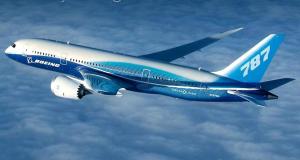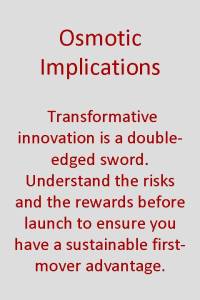radical innovation
The Dreamliner and the Risks of Transformative Innovation
In October of 2011 Boeing launched a new plane, said to be the most innovative new aircraft in the commercial space in decades. Airlines were lining up to order their own, with Japanese airline ANA waiting over 3 years for its first craft to be delivered. Customers paid up to $30,000 per seat to take a ride in the new plane that had the entire industry and traveling world abuzz. The plane offered huge improvements in energy efficiency, was made from a variety of high tech composite materials, and included a wide-spectrum of high-end consumer features like increased space, reduced noise, modular bathrooms, and even a LED light show during preparation for take-off. It seemed like a huge leap for Boeing and the aircraft industry.

However in the time since, Boeing has been dogged with problems: Cockpit windows have cracked multiple times, now three active Dreamliners have had overheating problems related to their lithium ion batteries, and two planes have had fuel leak problems. Given that only 50 Dreamliners are in service (with hundreds more on delayed order) these are potentially scary indications that the entire plane design may need to be reconsidered. The issue has even led US investment bank Goldman to downgrade Boeing stock from “conviction buy” to “buy” while the issues are reviewed by the FAA.
The question that has to be on the mind of many Boeing executives is whether the Dreamliner was too big of a risk – to big of a redesign and innovation – to have been taken in the first place; particularly in an industry with such high regulatory and consumer scrutiny.
But has the Dreamliner really failed? Or is it simply experiencing the rocky beginning that many transformational innovations go through? What does this case say about the relative merits of the first-mover advantage versus being a fast-follower? Let’s consider the details and the impact the Dreamliner has had on its:
– Industry/competitors: the airline manufacturing industry is particularly competitive, with high levels of capital required. In fact, two major western companies now dominate the consumer and military industry, with Boeing and Airbus fighting for market share. Airbus is set to launch their own next generation craft next year – it too relies on the same type of batteries found to cause issues for Boeing. Boeing has the first-mover advantage in that they’ve defined the next stage of technical development and can capture the early market – whatever features Airbus shows in the A350 will almost certainly have been inspired by the 787. Airbus however has the fast-follower advantage: the chance to quickly adapt its competitor’s technology while making necessary improvements to have an even better product at launch.
– Market: the airline industry is intensely competitive, with any opportunity to gain consumer share coveted. The Dreamliner captured the imagination of the commercial airline industry, with airlines queued up to place orders to not only gain an edge against their competition but also to keep up. The Dreamliner has been a success, but it is vulnerable to being displaced by its competition based on the difficulties relating to safety. Unfortunately, in the airline industry almost any issue quickly escalates to a safety concern. No amount of internal testing can replace use in the field, so these ‘teething’ problems are almost inevitable in such an innovation. Only time will tell if these are early indications of incomplete qualification of designs and innovation or just minor bugs that needed to be worked out.
– Consumers: the Dreamliner did something no plane has done for decades – it captured the enthusiasm and interest of the flying public. Boeing was able to become synonymous with innovation in the industry. This interest almost certainly contributed to the early success in selling the plane within the airline market. Boeing now has the challenge of resolving safety issues in a way that assures the consumer of the concern for safety. This means solving the quickly and completely. Another instance of having the plane grounded might be permanently disastrous for the Dreamliner and Boeing brand in the eyes of consumers, especially related to new innovations.
 That the launch of a transformative new airliner design will meet with some growing pains should have been no surprise to Boeing executives. With any innovation there is a level of risk involved in introducing it to the market – whether that be market acceptance, technical success, or speed of adoption (among other factors). The bigger question is whether Boeing understood the risks before launch and fully evaluated the upside versus the potential downside of making such a transformational leap. The Poole College of Management provides a great discussion on ‘Managing Levels of Innovation Risk’ on its Enterprise Risk Management page. For the executive or innovation leader it is very important to understand the organizational needs – for real breakthrough growth or to capture a new market segment transformation innovation can be a necessity. However, it may be enough to make more sustainable, low risk incremental innovations in order to obtain the same gains.
That the launch of a transformative new airliner design will meet with some growing pains should have been no surprise to Boeing executives. With any innovation there is a level of risk involved in introducing it to the market – whether that be market acceptance, technical success, or speed of adoption (among other factors). The bigger question is whether Boeing understood the risks before launch and fully evaluated the upside versus the potential downside of making such a transformational leap. The Poole College of Management provides a great discussion on ‘Managing Levels of Innovation Risk’ on its Enterprise Risk Management page. For the executive or innovation leader it is very important to understand the organizational needs – for real breakthrough growth or to capture a new market segment transformation innovation can be a necessity. However, it may be enough to make more sustainable, low risk incremental innovations in order to obtain the same gains.
To the Osmotic Innovator, the warning is to be certain of the organizational goals in relation to an innovation initiative. While transformational innovations are exciting and capture the imagination both internally and externally they also carry a very high risk profile and can do long term damage to a brand and a company that undertakes them. There is a case to be made that in some cases incremental or core innovations can represent a more easily digestible risk profile.
So where does Boeing net-out? Boeing, hopefully, made the evaluation that its position required or allowed it to take a gamble on a transformational innovation. Rather than suffering the innovators dilemma and being outpaced by other firms it would disrupt its own business and take the risk necessary to do so. While being first-mover allowed them to capture a potentially huge share of the market for the Dreamliners benefits (high efficiency longer-range medium sized planes with enhanced consumer experience) and set the industry standard, technical and supply problems have given its competitor a chance to both learn and catch-up, potentially offering a better comparable product when they do launch. Boeings willingness to work with regulators to make its system safe speaks well to regulatory agencies, airlines, and travelers; but it is inherent that these changes are made quickly to repair the damage to the brand and fend off otherwise equivalent competitor offerings.
The future success of the Dreamliner and its place in history (as either a transformational innovation or a failed early stage technical innovation bested by the fast-followers) will rest on Boeings willingness to dedicate resources to solving its problems quickly and efficiently and on the ability of its competitors to leverage these first-mover difficulties to their advantage.